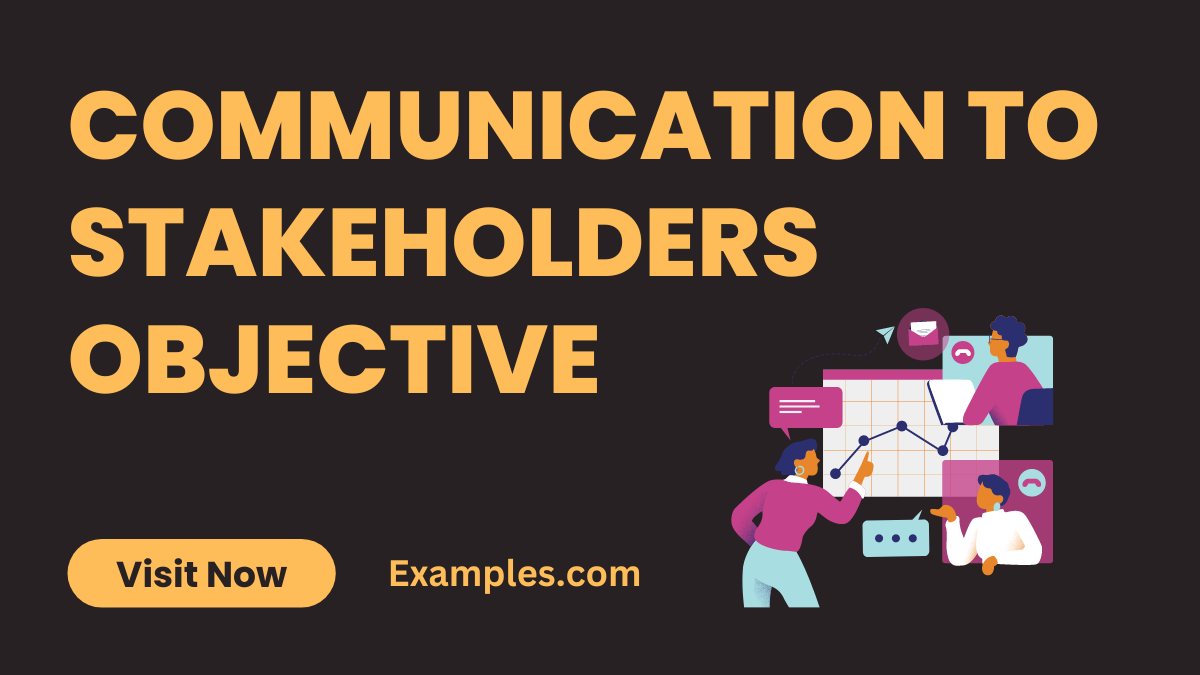19+ Communication to Stakeholders Objective Examples
Welcome to the comprehensive guide on Communication to Stakeholders Objectives. In this detailed exploration, we delve into effective strategies, showcasing Communication Examples that bring concepts to life. Elevate your understanding of stakeholder engagement with actionable tips and real-world scenarios. Whether you’re a seasoned professional or a newcomer, this guide offers valuable insights to enhance your communication prowess. Dive into our curated content and discover the power of purposeful communication with stakeholders. Let’s embark on this insightful journey together.
What is Communication to Stakeholders Objective?
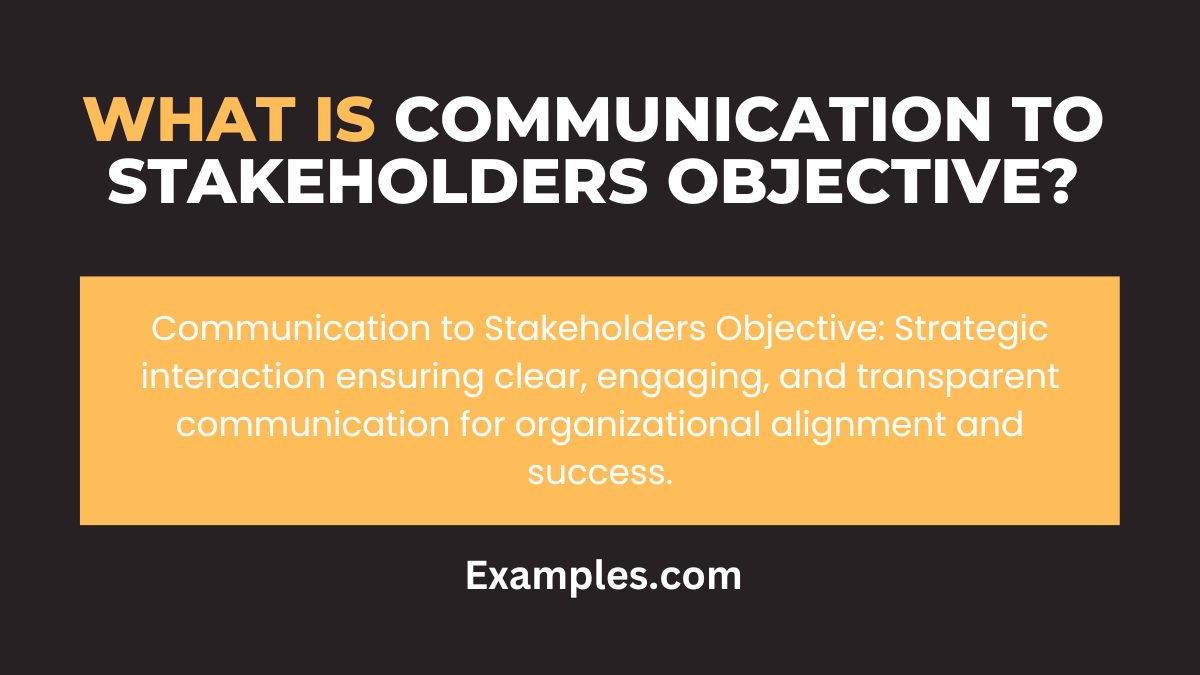
Communication to Stakeholders Objective refers to the purposeful and strategic interaction a business or entity undertakes to convey information to its stakeholders. In simple terms, it involves articulating specific goals and intentions when communicating with individuals or groups invested in the organization. This proactive approach ensures clarity, transparency, and effective engagement. By defining and understanding Communication to Stakeholders Objective, businesses can cultivate stronger relationships and navigate challenges with a shared understanding of their goals and values.
What is the best Example of Communication to Stakeholders Objective?
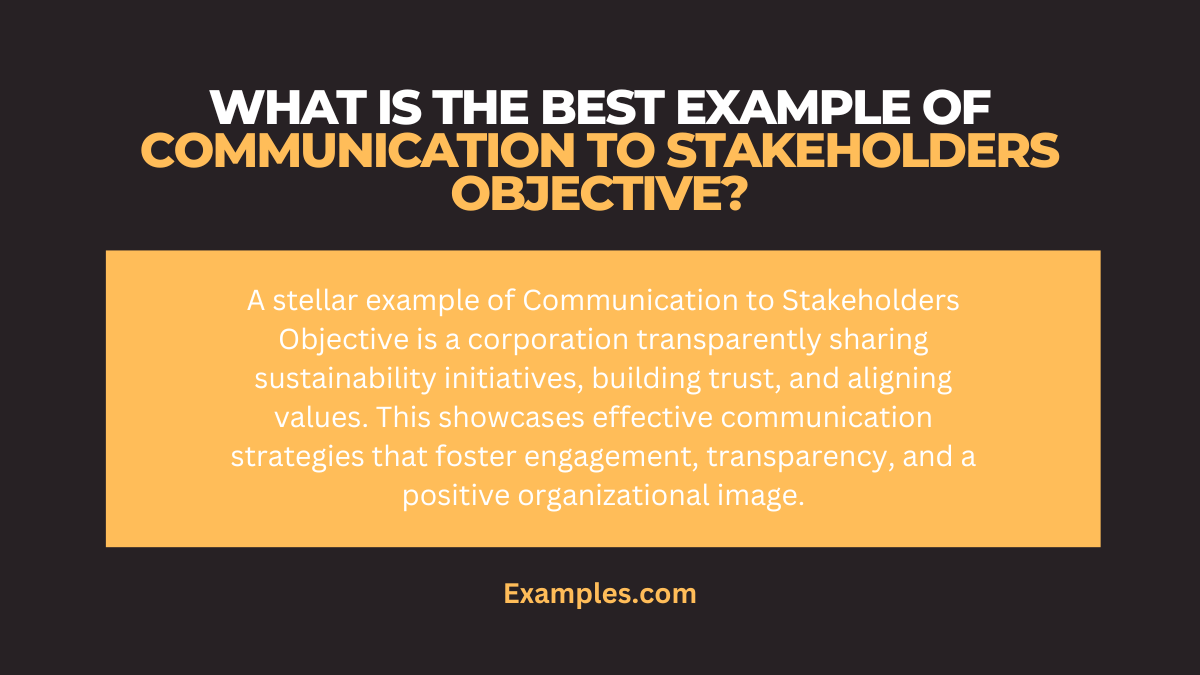
In the realm of Communication to Stakeholders Objective, a standout example is the proactive disclosure of environmental initiatives by a global corporation. By transparently communicating sustainability goals, progress, and challenges to stakeholders, the company fosters trust and aligns values. This example emphasizes the importance of clear, honest, and timely communication, showcasing how businesses can integrate objectives seamlessly into their narrative. Discover the intricacies of this exemplary case, unraveling the key elements that make it a benchmark for effective stakeholder communication.
20 Communication to Stakeholders Objective Examples
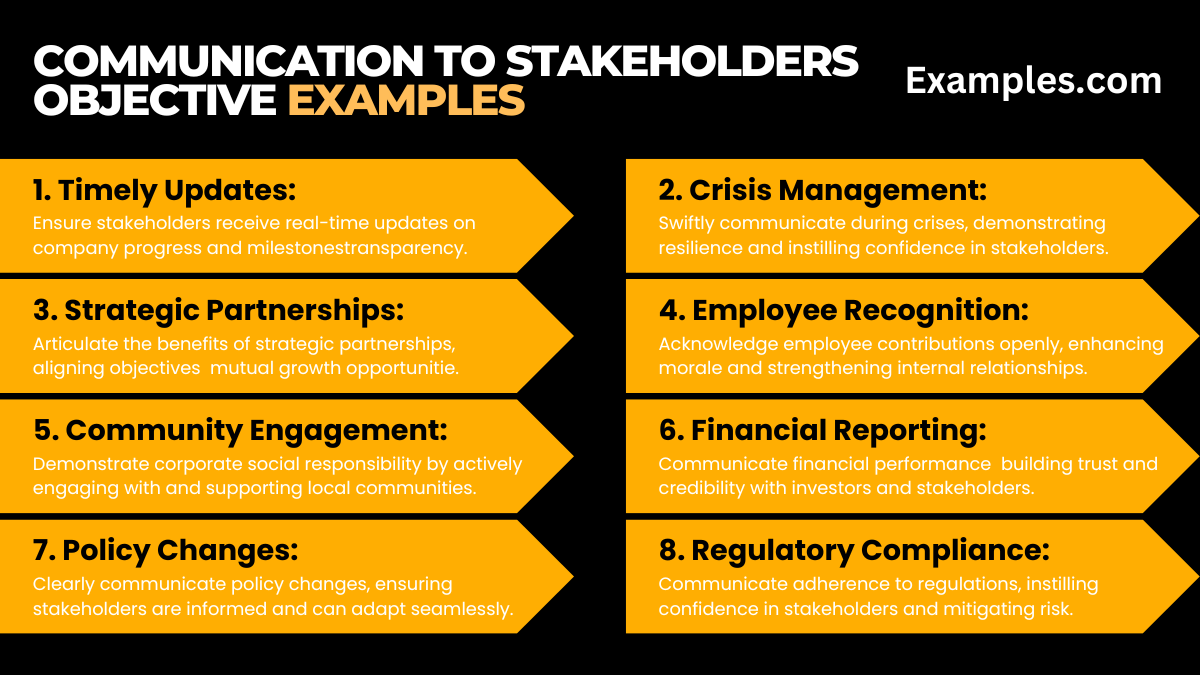
Unlock the art of effective stakeholder engagement with our curated list of 20 Communication to Stakeholders Objective examples. From crafting compelling narratives to navigating challenges, these instances exemplify strategic communication.
- Timely Updates: Ensure stakeholders receive real-time updates on company progress and milestones, fostering transparency.
- Crisis Management: Swiftly communicate during crises, demonstrating resilience and instilling confidence in stakeholders.
- Strategic Partnerships: Articulate the benefits of strategic partnerships, aligning objectives and showcasing mutual growth opportunities.
- Employee Recognition: Acknowledge employee contributions openly, enhancing morale and strengthening internal relationships.
- Customer Feedback Integration: Incorporate customer feedback into communications, showcasing responsiveness and commitment to improvement.
- Community Engagement: Demonstrate corporate social responsibility by actively engaging with and supporting local communities.
- Product Launch Communication: Create anticipation and excitement through clear and compelling communication during product launches.
- Financial Reporting: Communicate financial performance transparently, building trust and credibility with investors and stakeholders.
- Policy Changes: Clearly communicate policy changes, ensuring stakeholders are informed and can adapt seamlessly.
- Corporate Social Responsibility: Showcase CSR initiatives and their impact, reinforcing the company’s commitment to positive change.
- Diversity and Inclusion Initiatives: Communicate efforts and progress in fostering diversity and inclusion, emphasizing the company’s values.
- Digital Transformation Updates: Keep stakeholders informed about digital transformation initiatives, showcasing adaptability and innovation.
- Supply Chain Communication: Transparently communicate supply chain updates, addressing potential concerns and ensuring stability.
- Feedback Channels: Establish open channels for stakeholder feedback, demonstrating a commitment to continuous improvement.
- Regulatory Compliance: Communicate adherence to regulations, instilling confidence in stakeholders and mitigating risk.
- Technological Advancements: Share updates on technological advancements, highlighting the company’s commitment to innovation.
- Health and Safety Communications: Prioritize clear communication about health and safety measures, ensuring a secure environment for stakeholders.
- Merger and Acquisition Strategies: Communicate merger and acquisition strategies, outlining benefits and addressing concerns.
- Sustainability Initiatives: Showcase sustainable practices and their impact, aligning with the growing importance of environmental responsibility.
- Educational Initiatives: Communicate educational initiatives, emphasizing the company’s commitment to learning and development.
Communication to Stakeholders Objectives and Goals:
Unlock the power of purposeful communication with our guide on Communication to Stakeholders Objectives and Goals. Delve into strategic approaches to define and achieve objectives, ensuring alignment and engagement with stakeholders. Explore real-world examples that illustrate effective communication practices for diverse organizational goals.
- Strategic Alignment: Align organizational goals with stakeholder expectations through clear and consistent communication.
- Crisis Mitigation: Communicate crisis management objectives to stakeholders, ensuring a unified and informed response during challenging times.
- Innovation Showcase: Highlight innovation objectives, fostering excitement and engagement among stakeholders for future advancements.
- Brand Reinforcement: Reinforce brand objectives through communication, building a strong and consistent brand image among stakeholders.
- Adaptability Messaging: Communicate adaptability goals, showcasing the organization’s ability to navigate change and uncertainty.
Communication to Stakeholders Objectives in Resume:
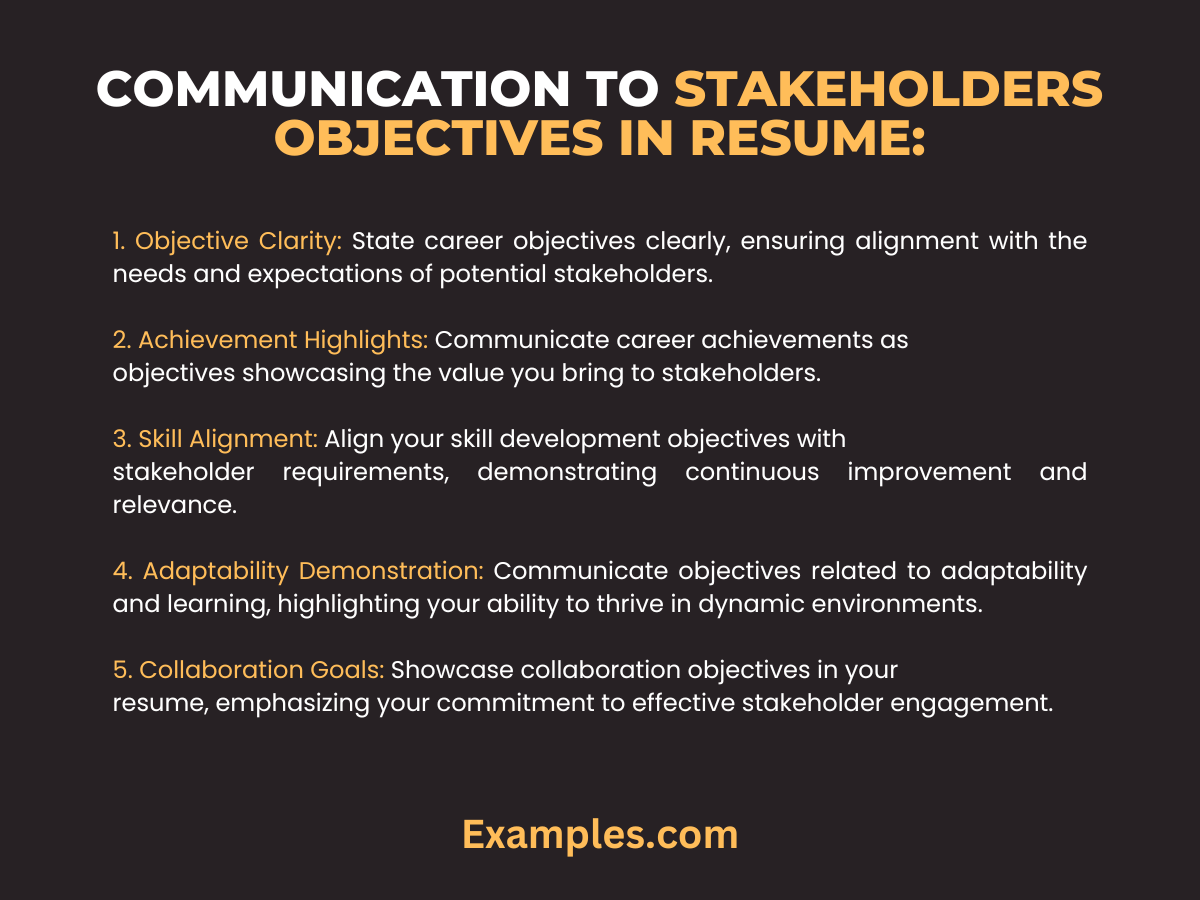
Craft a compelling narrative in your resume with our guide on Communication to Stakeholders Objectives. Learn how to articulate your professional goals, showcase achievements, and align with stakeholder expectations. Explore examples that demonstrate effective communication strategies in resume objectives.
- Objective Clarity: State career objectives clearly, ensuring alignment with the needs and expectations of potential stakeholders.
- Achievement Highlights: Communicate career achievements as objectives, showcasing the value you bring to stakeholders.
- Skill Alignment: Align your skill development objectives with stakeholder requirements, demonstrating continuous improvement and relevance.
- Adaptability Demonstration: Communicate objectives related to adaptability and learning, highlighting your ability to thrive in dynamic environments.
- Collaboration Goals: Showcase collaboration objectives in your resume, emphasizing your commitment to effective stakeholder engagement.
How to Set Communication Objectives for Stakeholders?
Setting effective communication objectives for stakeholders is paramount for organizational success. In this guide, we’ll navigate the intricacies of crafting objectives that resonate, align, and engage stakeholders.
- Define Your Stakeholders: Identify and categorize your stakeholders, understanding their needs and expectations.
- Understand Stakeholder Objectives: Delve into their priorities, concerns, and aspirations, aligning your communication goals accordingly.
- Clarity is Key: Craft clear and concise communication objectives, using easily understood language.
- Prioritize Key Messages: Identify key messages that align with organizational and stakeholder objectives.
- Select Appropriate Channels: Choose channels that resonate with stakeholders, enhancing message effectiveness.
- Set Measurable Goals: Establish measurable goals, such as increased engagement or improved satisfaction.
- Establish Timelines: Define timelines for achieving communication objectives, creating urgency.
- Feedback Mechanisms: Implement feedback mechanisms for continuous improvement based on stakeholder responses.
- Adaptability and Flexibility: Be adaptable and flexible, adjusting objectives based on evolving needs.
- Evaluate and Iterate: Regularly evaluate impact and iterate for continuous enhancement.
What are the Key Objectives of a Communication to Stakeholders Plan?
Crafting a robust Communication to Stakeholders plan necessitates clear objectives. Here’s a concise exploration of key goals for effective stakeholder communication:
1. Clarity in Messaging: Define objectives with precision to minimize ambiguity and ensure clear communication.
2. Stakeholder Engagement Enhancement: Foster meaningful engagement tailored to diverse stakeholder groups for lasting relationships.
3. Building Trust and Credibility: Establish trust through authentic, transparent, and reliable communication practices.
4. Goal Alignment: Align communication seamlessly with broader organizational goals for cohesive messaging.
5. Adapting to Change: Communicate adaptability and responsiveness to navigate challenges effectively.
6. Timely and Relevant Information Dissemination: Prioritize timely, relevant information distribution to empower stakeholders in decision-making.
7. Managing Expectations: Clearly define and manage expectations through proactive communication strategies.
8. Feedback Mechanism Implementation: Establish robust mechanisms for receiving and incorporating stakeholder feedback.
9. Crisis Communication Preparedness: Develop strategies for clear and decisive communication during challenging situations.
10. Continuous Improvement and Evaluation: Implement objectives focused on continuous improvement, regularly adapting strategies based on feedback and organizational needs.
organizational success. This comprehensive guide has illuminated key strategies, emphasizing clarity, engagement, and trust. Explore diverse examples showcasing effective communication in action. Empower your organization with these insights, ensuring robust stakeholder connections and navigating challenges with strategic finesse.



